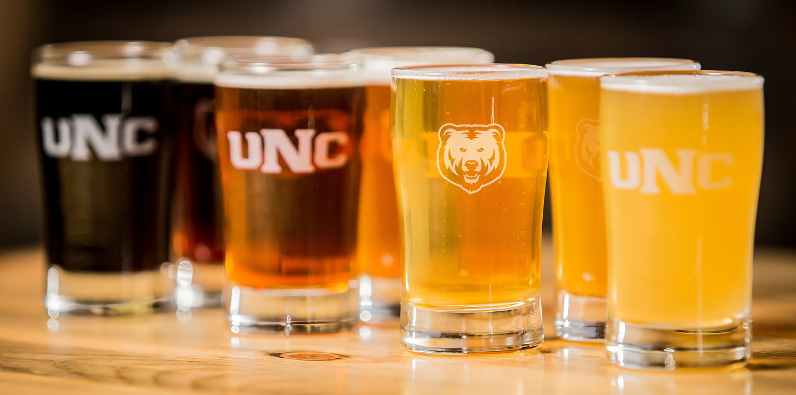
In the corner of a lab room in Candelaria Hall is a handheld tool that looks similar to a barcode scanner grocery store clerks use at the checkout line. However, this tool is called an X-Ray Fluorescence (XRF) spectrometer, and instead of deciphering the price of a cereal box, the XRF determines what elements make up an item it is scanning.
“The technology shoots a low-energy X-ray beam at the item we’re interested in, knocking around the electrons in the atoms, which then send a burst of energy back to the instrument to be measured,” said Associate Professor of Anthropology Marian Hamilton, Ph.D.
Hamilton has been using the XRF at UNC for research and coursework since 2021. The technology is particularly helpful in her paleoecology research, where she can determine the chemical composition in animal teeth and bone fossils, revealing what animals ate when they were alive.
However, Hamilton says the small machine can detect most elements on the periodic table, making the application of the XRF endless.
“The very cool part is that every single element is going to burst back a unique energy signature when its atoms get knocked around, so if we can measure how many little bits of energy called photons come in at each one of these particular energy strengths, we can see what elements are inside any item,” Hamilton said.
As it turns out, some of those elements can be pretty dangerous.
One of the most recent uses of the XRF at UNC was a project dealing with 18th-century books. Angela Naumov, manager of archives and rarebooks atDenver Botanic Gardens, reached out to Hamilton asking if they could collaborate and use the XRF technology to analyze the composition of their rare books within the collection of the Gardens’ Helen Fowler Library.
Naumov said they learned about The Poison Book Project, which focuses on identifying potentially toxic pigments used in bookbinding components and how to handle and store toxic collections more safely. Not knowing if any in their collection contained these dangerous elements, she wanted to do the same for their historic books.
“As our library is part of Denver Botanic Gardens, all of our books relate in some capacity to botany and horticulture,” Naumov said. “Our rare books contain many incredible examples of early European herbals and accounts of explorations and expeditions of plants. So, we want to preserve them mostly for educational value.”
Happy to help, Hamilton enlisted her XRF Lab students, Alex Galloway, Aliyah Archer and Mackenzie McDaniel, and packed up the XRF to bring it to the Gardens’ library. There they scanned books dating back to the 1800s to see if they were contaminated with toxins including lead, arsenic, mercury and cadmium.
“It’s amazing to use the knowledge we’re gaining to help people and not to do it for just the sake of knowledge. The professors here teach in applicable ways."
Alex Galloway
“It was really fascinating handling these really old books and seeing all the illustrations of the books that were fairly niche gardening books,” said Anthropology senior Alex Galloway. “There were some that were native to New York, some from London, so it was fun to compare the differences in them.”
“This is the kind of thing people don’t often think about,” added Anthropology junior Aliyah Archer. “There are all types of contaminants in our daily items, so it was cool to see the evolution of what came up in the older books. The older the books were, the more toxins they had, which was our original hypothesis.”
The students spent a full day analyzing 93 volumes to determine if they had any “poison” in them and learned how to carefully handle the fragile manuscripts.
“A lot of what we found on the books was lead everywhere, which wasn’t surprising,” Galloway said. “We also saw a little bit of mercury, which shows up in red dyes, and arsenic, which shows up in green dyes.”
Galloway says the green they were looking for is called Sheele’s Green, a common dye that was used in making books back in the day. Out of the 93 books, only three had arsenic present.
“Arsenic usually accompanies these books from the 1800s that have a really brilliant jade green color,” Hamilton explains. “In a couple of the books, there were really beautifully colored monographs, and a lot of those were done by using these really toxic chemicals, so if you’re touching the arsenic books, there’s a good chance that you’re getting some of that coming off onto your skin, which is a hazard.”
Hamilton says there isn’t much that can be done to abate the arsenic on the books other than to contain it, which is what Naumov and her colleagues plan to do. The next step is to create custom enclosures for the books found with arsenic and label them as such so the public is aware of the need to handle them with custom care.
“Having them in individual boxes will also keep any potential dustings of the materials contained within their own little environments and not come into contact with other books in the collection, and we’ll require anyone handling them to wear gloves,” Naumov added.
While the work only lasted a day, Hamilton says it was a skill set the students will likely use once they begin their careers.
“Especially as anthropology majors, many of these students are looking into conservation, going into curation and museum work, so it’s really important to have that background knowledge of looking at an artifact, knowing how old it is, and checking to see if it has mercury or other toxins to be able to preserve the artifact,” Hamilton said.
In this case, Hamilton says, without knowing that the botany books needed extra and specific care, information in them about the history of herbal science and how it progressed could have been lost.
Which is exactly what intrigued Galloway most about this project.
“This is what anthropology is all about,” Galloway said. “Studying different cultures and how they reacted or did certain things differently, and that was clearly shown in the books. So, it was cool to be a part of something where you are working to preserve books and preserve these people’s perceptions. I appreciate an archivist's job so much more now.”
Next Chapter
While she enjoyed examining the rare books with the XRF, Archer is interested in using the machine to conduct research in the public health industry. Beginning last year, Archer tested different types of everyday kitchen spices for heavy metals.
“I read different consumer reports about contamination in cinnamon, so I took samples of a bunch of different types of commonly used spices to see what I could find, and luckily I didn’t find anything major,” Archer said.
Using that data, Archer will now look at the element breakdown of the spices to see the nutritional value of each of them. Her goal is to get her master's in public health after she graduates to interlace the human side of anthropology with the medical side of public health. She says her hands-on experience in using the XRF technology will greatly help her in the future.
“It’s pretty cool to have knowledge in this experience, and I’m really looking forward to continue building this niche skill,” Archer said. “I have a lot of different ideas of how the XRF could be used in the public health field for testing things for different contaminants, and there are probably potentials that we haven’t even thought of or discovered yet since it’s still relatively new in this field.”
Galloway is also interested in using his Anthropology degree to go into the public health industry. He plans to get his master's in public health at UNC and focus his thesis on XRF data and community health centers for disadvantaged groups such as immigrants and refugees. He gained this passion through his hands-on coursework dealing with community outreach, including projects like The Poison Books testing at Denver Botanic Gardens.
“It’s amazing to use the knowledge we’re gaining to help people and not to do it for just the sake of knowledge. The professors here teach in applicable ways,” Galloway said. “It’s not just theoretical, the skills we learn are oriented towards gaining skills to get jobs and it’s nice to be around people that care about the community.”
Community members like Naumov are grateful UNC and its students are willing to share their knowledge and help with projects outside of campus.
“It was an absolute delight to work with Dr. Hamilton and the students,” Naumov said. “It was apparent that they were excited and interested not only in the testing itself but in the items they were testing as well.”
More Stories
-
Daniel Garza’s Journey from Platteville, Colorado, to Stellenbosch, South Africa
Este artículo no está en español.
-
Crafting a Home Field Experience
Este artículo no está en español.
-
Doctoral Candidate Tackles Social Issues Using Data Science
Este artículo no está en español.
-
Bridging the Gap Between High School and College: Frontiers of Science Institute
Este artículo no está en español.





